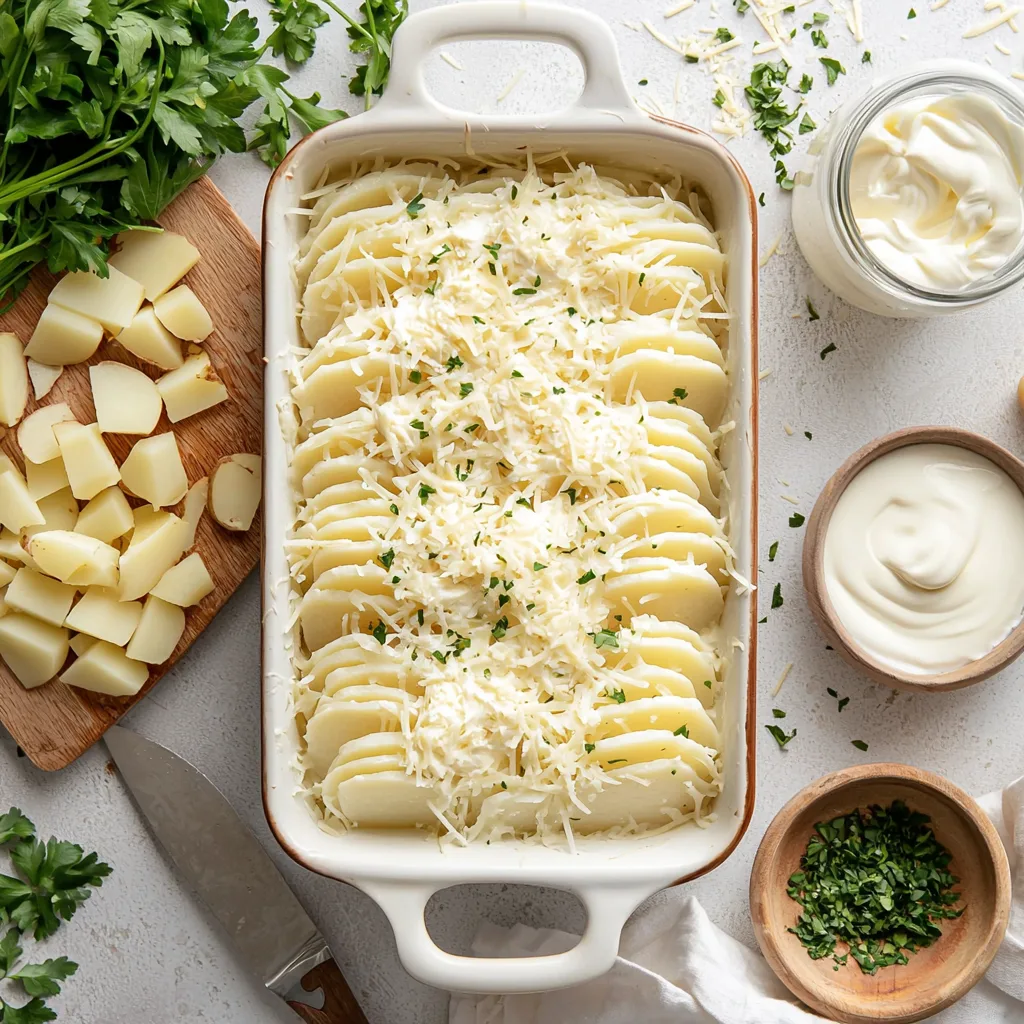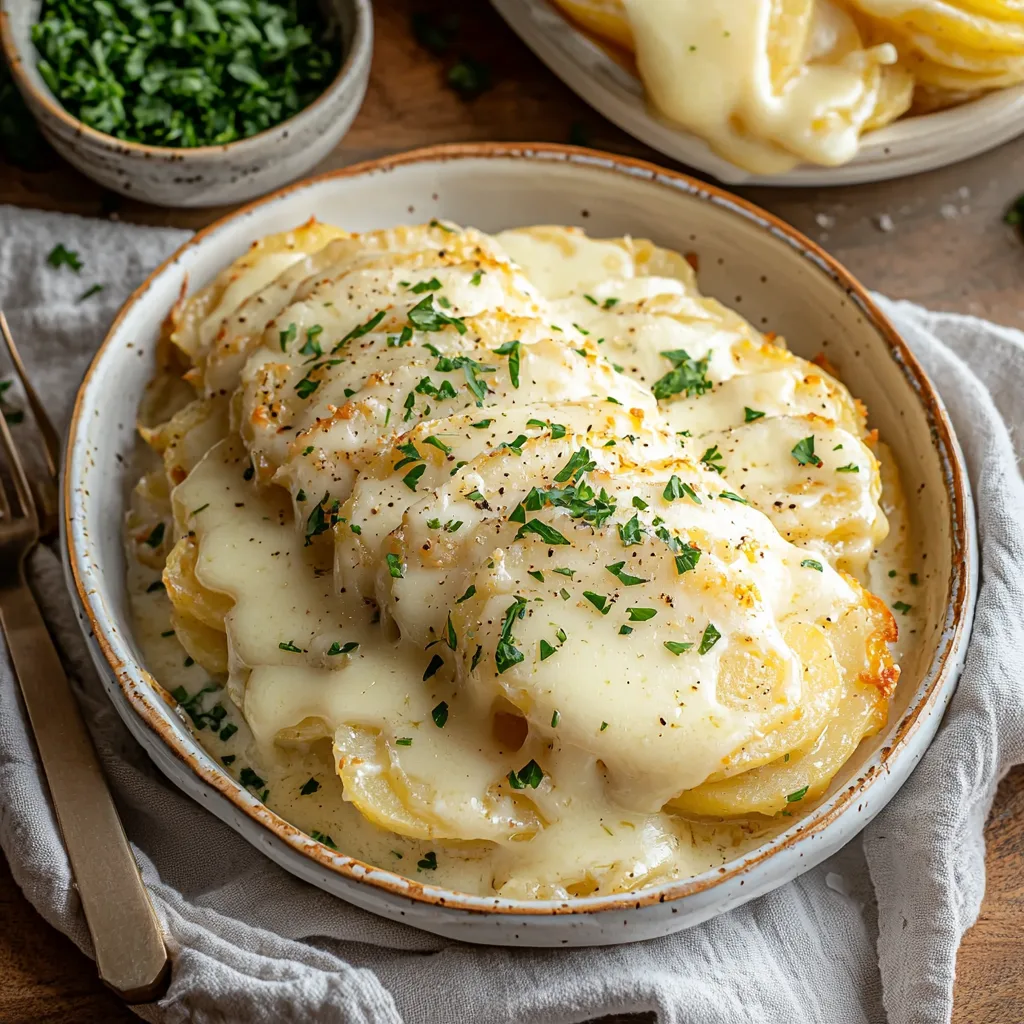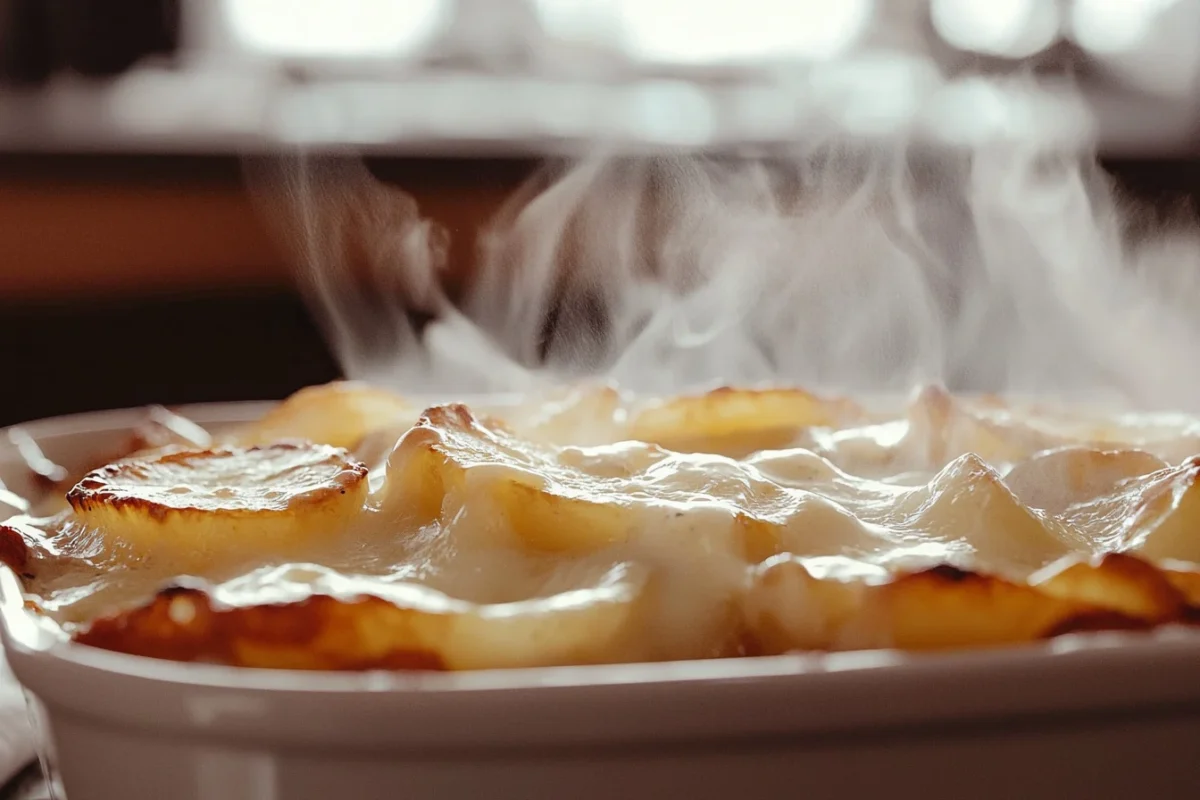Should you boil potatoes first for scalloped potatoes? This question has sparked debates among home cooks for years. Some swear by pre-boiling to ensure soft and evenly cooked layers, while others believe raw potatoes bake just fine in a creamy sauce. The answer depends on your preferred texture and the time you have available.
Next, scalloped potatoes are a timeless dish loved for their creamy layers and rich flavor. Whether served as a comforting family meal or a side dish at gatherings, they never fail to impress. Also, pre-boiling can save baking time and ensure tender results.
In addition, the right method can make all the difference in creating perfect scalloped potatoes. From soft, melt-in-your-mouth bites to firmer, structured layers, the choice is yours. Keep reading to discover expert tips and techniques that will help you master this classic dish. Your next potato dish might just be your best one yet!
Table of Contents
The Role of Pre-Boiling Potatoes in Scalloped Dishes
Texture Differences Between Raw and Boiled Potatoes
Pre-boiling potatoes for scalloped dishes significantly affects their texture. Boiled potatoes create a softer, smoother consistency that blends seamlessly with creamy sauces. On the other hand, raw potatoes retain a firmer texture, offering a slightly more defined structure after baking.
Additionally, boiled potatoes absorb sauce more effectively, enriching each bite with flavor. However, over-boiling can cause slices to become too soft, making them prone to breaking. Balancing the cooking process ensures that the potatoes remain firm enough to hold their shape but tender enough to blend with the sauce.

Properly handling the texture difference allows you to customize your dish based on your preference. Some people enjoy the soft and creamy feel of pre-boiled potatoes, while others appreciate the distinct bite of raw slices.
No matter which method you choose, understanding these texture differences helps you achieve delicious results every time.
How Pre-Boiling Affects Cooking Time
Should you boil potatoes first for scalloped potatoes? This question becomes even more relevant when considering how boiling impacts overall baking time. Pre-boiled potatoes significantly reduce the time needed in the oven. They cook more evenly and absorb sauces better, resulting in a consistent texture throughout the dish.
Additionally, boiling ensures that no potato slices remain undercooked, which can sometimes happen when using raw potatoes. However, boiling introduces an extra step, which might not be ideal for those looking for a quick preparation process.
Another factor to consider is the balance between softness and structure. Over-boiling can make the slices too fragile, while under-boiling may leave them too firm.
Finding the right timing during pre-boiling can make all the difference in your final dish. With proper technique, you can achieve the perfect balance of tenderness and structure in your scalloped potatoes every time.
Pros and Cons of Boiling Potatoes Before Baking
Benefits of Pre-Boiling for Even Cooking
Pre-boiling potatoes offers several benefits for scalloped potato dishes. First, it ensures consistent and even cooking, preventing raw or crunchy slices in the final dish. Additionally, boiled potatoes absorb creamy sauces better, creating a more cohesive flavor throughout the layers.
Another advantage is the reduced baking time, which is perfect for busy cooks. Pre-boiled potatoes also layer more easily without breaking. Their soft texture creates a more uniform dish, eliminating overly firm or undercooked sections.
However, it’s essential to monitor the boiling time closely to avoid overcooking. Over-boiled potatoes can become mushy and fall apart during layering.
When done right, pre-boiled potatoes provide a dependable foundation for scalloped dishes. The combination of even cooking, consistent layering, and sauce absorption makes this method a reliable choice.
With proper timing and technique, pre-boiled potatoes contribute to a delicious and satisfying meal.
Drawbacks of Pre-Boiling in Scalloped Potatoes
While pre-boiling offers several benefits, it also raises the question, ‘Should you boil potatoes first for scalloped potatoes?’, especially when considering texture consistency. One major drawback is the risk of overcooking the potatoes during the boiling stage. Over-boiled slices may fall apart during layering, resulting in a mushy texture.
Additionally, boiling removes some of the natural starch from the potatoes, which can slightly affect the sauce’s creaminess. This extra step also adds to the overall preparation time, making it less appealing for those seeking a quick dish.
Furthermore, boiled potatoes can sometimes absorb too much moisture, which might lead to a soggy final result. Careful timing and attention are required to avoid these pitfalls.
If you prefer a firmer texture and more defined layers, you might want to consider using raw or steamed potatoes instead. Both methods have their advantages depending on your desired outcome.
Alternative Methods to Prepare Potatoes for Scalloped Dishes
Using Raw Potatoes for a Firmer Texture
When deciding on your method, ‘Should you boil potatoes first for scalloped potatoes?’ becomes a key consideration for achieving your desired texture. Raw potatoes are an excellent choice for those who prefer a firmer bite and more structured layers. They hold their shape better during baking, creating a more defined dish. Additionally, raw potatoes release natural starch as they cook, contributing to a creamier sauce texture.
However, baking raw slices requires more time and attention to ensure even cooking. Uneven slicing can also result in inconsistent textures, with some slices remaining too firm while others turn mushy. To get the best results, ensure potato slices are evenly cut and layered properly.
Interestingly, studies from the USDA on potassium and potato preparation reveal that cooking methods, including boiling and baking, can influence the nutritional content of potatoes.
If you have time, raw potatoes can deliver a satisfying and visually appealing scalloped dish. With proper slicing, seasoning, and baking, they yield an impressive texture and flavor many home cooks love.
Steaming Potatoes as a Middle Ground
If you’re still wondering, ‘Should you boil potatoes first for scalloped potatoes?’, steaming might offer the balance you’re looking for. Steaming provides a middle ground between raw and boiled potatoes. It partially cooks the slices, shortening baking time while maintaining a firm texture.
Steamed potatoes are also less likely to fall apart during layering, preserving their structure throughout the dish. Additionally, steaming helps retain more nutrients compared to boiling, making it a slightly healthier option.
Another advantage of steaming is that the potato slices absorb sauce efficiently, creating a flavorful bite every time. However, timing is crucial to avoid over-steaming, as excess moisture can cause the potatoes to become overly soft.
With careful preparation, steaming provides consistency and reliability. It’s a versatile method that works well for both casual meals and special occasions, delivering excellent results every time.
Common Mistakes When Preparing Scalloped Potatoes
Overcooking Pre-Boiled Potatoes
One of the most common mistakes when preparing scalloped potatoes is overcooking during the boiling stage. Over-boiled potatoes become too soft and fragile, making them difficult to layer and prone to falling apart.
To avoid this, potatoes should be boiled until just tender, not fully cooked. Additionally, immediately transferring boiled slices to cold water can stop further cooking and help maintain their structure.
Proper timing and attention during boiling ensure the potatoes contribute to a perfect scalloped dish with tender yet defined layers. Another useful tip is to check the potatoes frequently during boiling instead of relying on preset times.
Each potato variety cooks differently, so being attentive helps prevent overcooking. Overcooked potatoes not only lose their texture but also fail to absorb the sauce evenly.
By managing boiling time effectively, you’ll ensure the potatoes are firm enough for layering and soft enough for a satisfying bite in every spoonful.
Choosing the Wrong Potato Variety
Selecting the right potato variety is crucial for scalloped potatoes. Waxy potatoes, like Yukon Gold, hold their shape well and provide a creamy texture that works perfectly in layered dishes.
In contrast, starchy potatoes, such as Russets, tend to break apart when overcooked, creating mushy layers. Additionally, waxy potatoes absorb sauces effectively, enhancing the overall flavor and consistency of the dish.
Choosing the wrong type of potato can result in uneven cooking, mushy layers, or dry sections. Understanding these differences helps achieve the best results for your scalloped potato recipe.
Another practical tip is to experiment with different potato types to find the one that matches your preferred texture. Yukon Gold remains a versatile choice for most scalloped potato recipes, offering consistent results.
By selecting the right potato variety, you can create a well-balanced, flavorful, and visually appealing scalloped potato dish every time.
Expert Tips for Perfect Scalloped Potatoes
Balancing Sauce and Potato Texture
Achieving the perfect balance between sauce and potato texture is key to creating an irresistible scalloped potato dish. The sauce should be rich and creamy, coating each potato slice evenly without overpowering the texture.
Too much sauce can lead to a soupy dish, while too little may leave the potatoes dry. To prevent this, ensure your sauce has the right consistency—smooth and slightly thick. Additionally, layering the sauce evenly between potato slices helps distribute flavors throughout the dish.
Another important factor is pre-cooking the sauce slightly to blend the flavors and prevent it from separating during baking. Using a combination of cream, cheese, and seasonings can elevate the overall taste.
Finally, allow the dish to rest for a few minutes after baking. This helps the sauce thicken slightly, ensuring every bite is creamy, flavorful, and well-balanced.
Recommended Baking Times for Best Results
When determining baking times, ‘Should you boil potatoes first for scalloped potatoes?’ is a central question that impacts both time and texture. Pre-boiled potatoes require less baking time, making them ideal for busy cooks. On the other hand, raw potatoes need longer baking to achieve the same tenderness.
Typically, scalloped potatoes bake best at 350°F (175°C) for about an hour. Covering the dish with foil during the first half of baking helps trap steam and soften the slices evenly. Removing the foil in the final minutes creates a slightly crispy top layer.
If using raw potatoes, you might need to bake them for an extra 15–20 minutes. Checking doneness with a fork ensures the slices are tender without falling apart.
With the right baking time and method, you’ll achieve perfectly cooked scalloped potatoes every time. Both raw and boiled methods can deliver delicious results when executed carefully.
Popular Variations of Scalloped Potatoes Recipes
Classic Creamy Scalloped Potatoes
Classic creamy scalloped potatoes are a timeless favorite, offering a rich and velvety texture in every bite. This variation typically combines thinly sliced potatoes with a smooth, creamy sauce made from heavy cream, butter, and a hint of garlic. The sauce is carefully poured between each layer, ensuring every slice absorbs the flavor. Additionally, seasonings like salt, pepper, and fresh herbs are added to enhance the dish’s overall taste.
For those looking to elevate their dish, using cheese powder can add an extra layer of flavor and convenience. Check out this Scalloped Potatoes Recipe with Cheese Powder for a unique twist on the classic recipe.
Slow baking at a moderate temperature allows the potatoes to cook evenly while the sauce thickens perfectly. Another secret to achieving a perfect creamy texture is using a balanced ratio of sauce to potatoes. Letting the dish rest for a few minutes after baking also helps the sauce settle and firm up slightly. Whether served as a side dish at family dinners or festive gatherings, classic creamy scalloped potatoes remain a crowd-pleaser that never disappoints.

Cheesy Scalloped Potatoes with a Crispy Top
Cheesy scalloped potatoes with a crispy top bring an extra layer of indulgence to this beloved dish. This version includes a generous amount of grated cheese, such as cheddar, gruyère, or parmesan, layered between the potato slices and sauce. The cheese melts beautifully during baking, creating a gooey, flavorful center.
Additionally, sprinkling extra cheese on the top layer ensures a crispy, golden-brown crust that adds both texture and visual appeal. The key to achieving the perfect crispy top is removing the foil during the final 15 minutes of baking. This allows the cheese to brown evenly without burning.
For an added crunch, breadcrumbs or crushed crackers can also be sprinkled over the top layer before baking.
Cheesy scalloped potatoes with a crispy top are an ideal choice for cheese lovers and make a satisfying side dish for any meal.
Frequently Asked Questions (FAQs)
Is it better to boil potatoes before baking them?
Boiling potatoes before baking helps ensure even cooking and a tender texture in scalloped dishes. Pre-boiling reduces baking time and prevents the potatoes from being undercooked. Additionally, boiled potatoes absorb sauce more effectively, creating a creamier texture with every bite. However, over-boiling can make the slices too soft, causing them to fall apart during layering. If you prefer softer potatoes, boiling is a good option. For firmer slices, baking raw potatoes works well, offering a slightly different texture. Both methods have their benefits, and the choice depends on your preferred texture. Experiment confidently to find your ideal result!
Why won’t my scalloped potatoes get soft?
Scalloped potatoes may not soften if they are sliced too thick, preventing even cooking. Also, leaving the dish uncovered while baking can cause the sauce to evaporate too quickly. Dairy products, like cream, may curdle at high temperatures, affecting texture. Another factor could be using starchy potatoes instead of waxy varieties, which hold their shape better. Additionally, baking at too low a temperature can slow cooking. To fix this, slice potatoes evenly, keep the dish covered initially, and use the correct potato type. These adjustments help ensure perfectly tender scalloped potatoes every time!
Why are my scalloped potatoes not creamy?
Scalloped potatoes may lack creaminess if the sauce ratio is incorrect or the liquid evaporates during baking. Using low-fat dairy can also result in a thinner sauce that doesn’t coat the potatoes well. Additionally, overcooking can cause the sauce to separate, leading to a grainy texture. For the creamiest results, use full-fat cream or milk and layer the sauce evenly between the potato slices. Also, cover the dish during the initial baking phase to lock in moisture. Paying attention to these details will ensure a rich and creamy scalloped potato dish every time.
Do you always have to boil potatoes first?
Boiling potatoes before baking scalloped potatoes isn’t always necessary. It depends on your desired texture and time constraints. Pre-boiling shortens baking time and ensures softer, evenly cooked potatoes. However, raw potatoes can also deliver great results, especially if sliced thinly and baked at the right temperature. Raw slices may take longer to cook, but they retain a firmer texture. In addition, using a creamy sauce helps raw potatoes soften evenly during baking. Both methods work well, so the choice comes down to your preference and available preparation time. Experiment and see which suits your style best!
Perfect Scalloped Potatoes: Finding the Best Method for You
The question, “Should you boil potatoes first for scalloped potatoes?” ultimately depends on your preferred texture and cooking style. Pre-boiling ensures softer, creamier layers and reduces baking time. On the other hand, using raw potatoes offers a firmer texture with a slightly longer bake. Both approaches have their benefits, and neither is wrong—it’s all about your desired outcome.
Additionally, factors like potato variety, sauce consistency, and oven temperature play crucial roles in achieving the perfect dish. Next time you prepare scalloped potatoes, consider experimenting with both methods.
You might discover a new favorite way to prepare this classic recipe. Whether you prefer boiled or raw slices, scalloped potatoes are always a comforting and delicious choice. So, gather your ingredients, preheat your oven, and create a dish that suits your taste perfectly. Enjoy every bite and share your favorite method with friends and family!

